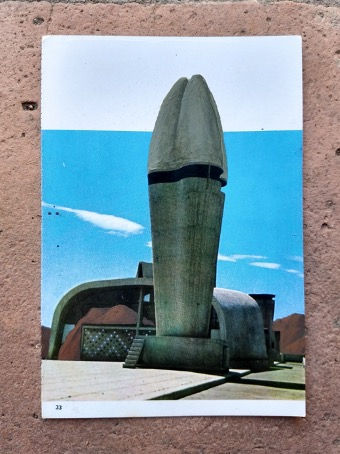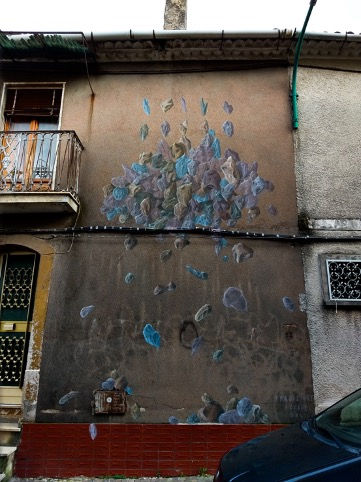DANIELE GREGORINI
- Riccardo Aimerito
- Oct 31, 2023
- 7 min read
WHEN DID YOU LEARN ABOUT THE WORLD OF STREET ART? CAN YOU TELL US MORE ABOUT YOUR ART GALLERY? DO YOU KNOW WHY THIS NEED TO OPEN AN ART GALLERY ARISE IN YOU? HOW DID OTHER ARTISTS RESPOND TO IT?
I remember my 12 or 13 years old self graffiting the neighbourhood with a few friends. In the city where I grew up there’s a lot of space with very recent historical stratifications, so we had at our disposal many ruins of large mansions or small remnants of houses or workshops, they became our playrooms and the first surfaces where we could try our first lettering and puppets. I remember my parents knew this and, instead of opposing or punishing me, they told me to remember that I was painting in my hometown and that the whole community would look at my art pieces, so they asked me to put a lot of effort into it. I think that was when I began to understand the responsibility of the artist and his role in our society. When I was in high school, I switched from writings to drawings, and from walls to papers. Then in 2012, I joined the Urban Center Cagliari, a small association that had just been set up with great visions to make a positive and intelligent impact on the territories, and I organised the first exhibitions, and the first festivals. I was the artistic director and curator maybe because I was seen as the creative one of the group. In those years we worked a lot: we experimented with methods of involvement, we created the first public installations. In Sardinia, people have been constantly painting on walls since the 1960s and any Sardinian has visited at least one of the island's open-air museums, but in Cagliari, the city where I studied and worked, no public art project had yet been made. There were already many Sardinian street artists being called upon by various festivals in Italy and abroad, so in 2014, together with the association, I felt that it was time to try to bring that traditional language closer to the capital city as well. We thought we would take care of a part of the city that at the time was very neglected, in the middle of two opposite neighbourhoods, a rich one and a poor one, and turn it into the city's first urban public art route where local artists and the many people passing by the island could paint or work, and where any other citizen could enjoy free art. With the first 15 murals we had established the Galleria del sale. This is one of the longest-running projects I have followed. It is now 9 years old and, after more than 70 works and countless workshops and guided tours, it continues to grow with the creation of almost a new work every month.

WHAT IS YOUR DEFINITION OF STREET ART? WOULD YOU SAY THAT THESE YEARS ARE THE GOLDEN AGE OF STREET ART?
I believe that street art is a term that would include the contemporary muralist movement. I believe that since the dawn of time, humans have always chosen the wall as the surface on which to report their creativity. Moving through history we encounter many types of muralism and many themes. I think we choose the wall because of its ability to convey any message. This ability was intuited by the communists in Latin America, the fascists in Europe, etc., and now it’s been intuited by artists, cultural promoters, schools and local residents, but also by big corporations, advertisers and the whole world. I grew up admiring from afar those artists who used muralism as a means to raise social issues, to create works of denunciation that stimulated people's critical spirit. My fear is that now even this movement is falling into the most empty consumerism, where the artwork becomes just an aesthetic gesture aimed at gratifying tourists, an object of consumption, created by some graphic designer with no real artistic research, motivated by money and not by a sincere communicative need.

WOULD YOU SAY THAT STREET ART/PUBLIC ART ARE MADE FOR THE ART SYSTEM OR FOR THE COMMUNICATION/DISSEMINATION SYSTEM?
I think this movement follows two directions: one towards the art system and the other towards free communication. One direction is legal and institutional, and the other is illegal and completely separated from that world. Personally, I embrace both of them and I believe that for the survival of the movement it is fundamental that one component remains completely free from market dynamics because it is the one that carries on the debate, experiments and evolves all the rest of the scene.

PLEASE TELL US MORE ABOUT YOURSELF. WHO IS DANIELE GREGORINI? WHAT GOALS DO YOU WANT TO ACHIEVE? DO YOU PERCEIVE YOURSELF MORE AS AN ARTIST OR AS A CURATOR?
I have learnt not to answer to this question. In my work as a curator I have met many fellow curators, directors or gallery owners who have always told me that I would not be able to do both. I understand them because the attention and imagination you put into curating is a lot, with the artists I work with I try to put myself at service, I try to give suggestions and not put the brakes on this process. So it’s pretty obvious that those ideas cannot be pursued by me as an artist. On the other hand, many artists do not see me as their colleague because of my role as a curator. For the time being, I believe I do not need or care about definitions. I pursue both careers, which stimulate me and fill me with emotions, with great commitment. I do what I do because I feel that’s what I’m supposed to. Each curatorial or artistic project is an opportunity for me to reflect on specific themes, to engage with others and to send out messages that I believe to be fundamental for our society. With the association we have done many projects that I wanted to do. One of them is Home Network: a network of artists which, on the one hand, is designed to support them in the production, communication and sales of their artworks, and on the other is conceived as a tool for public administrations, companies or private citizens to carry out projects with artistic leverage. We have crossed different needs and so far, among many difficulties, it makes us very satisfied.

HOW DOEAS A CURATOR ENTER THIS WORLD? SINCE SUCH ARTWORKS DOESN’T OFTEN FIT INTO TRADITIONAL EXHIBITION SPACES, HOW DOES HE CREATE AN ART EXHIBITION?
It is impossible to do street art exhibitions. It is possible to do exhibitions of artists who also do street art. A lot of street artists also do other types of artistic work. I have curated dozens of exhibitions of street artists but never a street art one.

IN THE PAST FEW YEARS THERE HAS BEEN MANY ATTEMPTS TO EXHIBIT STREET ART IN MUSEUMS, GENERATING MANY CONTROVERSIES FROM THE ARTISTS THEMSELVES, WHO HAVE ALWAYS BEEN AGAINST THE REMOVAL OF MURALS FROM THE SOCIAL CONTEXT THEY WERE PLACED. INSTEAD, THEY HAVE ALWAYS FAVOURED OPEN-AIR FESTIVALS AS A FAIR SOLUTION. IN REFERENCE TO THESE WORDS FROM THE BOOK “THE SROTY OF CONTEMPORARY ART” BY T. GODFREY, WHAT ARE YOUR THOUGHTS ON THE MATTER?
For many artists this is true, but many of those who have rejected to put their public works in museums reject festivals too because they see the same logic in the art market. As I said, selling an exhibition as a street art one looks like a scam to me. Removing a mural from a wall is a barbaric and violent act and responds to the need of turning our cities to tourist traps. In many cases murals, especially detached murals, are site-specific works, which were designed for the public place where they were made because of the desire of artists to give their vision to society. Removing the work from the place where it was made means depriving it of the meaning that the artist gave it. In addition, many of these works are kept locked in vaults in Switzerland with very high market prices that are not approved by the author, who doesn’t receive anything in return. As my grandmother used to say: add insult to injury. Having said that, I do not believe that street artists have favoured open-air festivals because they’re against the idea of putting their own works in museums. Street art only lives outdoors, just as a fish only lives in water.

WHAT SHOULD A CURATOR/ARTIST DARE TO DO?
I think the artist's greatest work should be his own research, so his own life journey. I think he should have the courage to make art and artistic research the greater part of himself. For what I think, when you choose to create art you connect with the past, present and future, and the artist should never ignore this, because he takes inspiration from the past and addresses it not only to the present but also the future. The artist must trust and respect his crazy part, the one he must preserve and discipline the most, and he must remember that the experimentation journey is made of disappointments and rejections, of sad moments and euphoric moments, and that the work he is looking for is to be found in all those phases. He must not be afraid to take this journey because it’s the path he chose. He can’t do otherwise. The artist path is made of bold choices: if there is no experimentation, there is no art. The curator should often have the courage to focus on the artists he believes in and not on the most famous and most marketable ones. For this reason, even the curator has a responsibility for our society because he is the one who contributes to defining who is an artist and who is not. Artists often become icons and examples of morality, which is why, in my opinion, the choice of curators, especially those who deal with public art, also depends to some extent on the ethical values of society. I would also suggest to both figures to have the courage to recognise the difference between aesthetics and art before all pictorial art turns into an exercise of formal beauty.

by RA/RC
for DARE CLAN




hinjewadi servie ++ wakad service ++ ravet service ++ baner service ++ pimri cinchwad ++
pimple saudagar ++ balewadi service ++ bavdhan service ++ shivaji nagar ++ viman nagar ++
kharadi service ++ magarpatta service ++ koregaon park ++ kalyani nagar ++ deccan service ++
pune service ++ pashan service ++ nigdi service ++ aundh service ++ bhumkar chowk service ++
sb road service ++ best city pine ++ best hotel pune ++ pune airport service ++ vip city pune ++
real city pune + + lovely desire pune ++